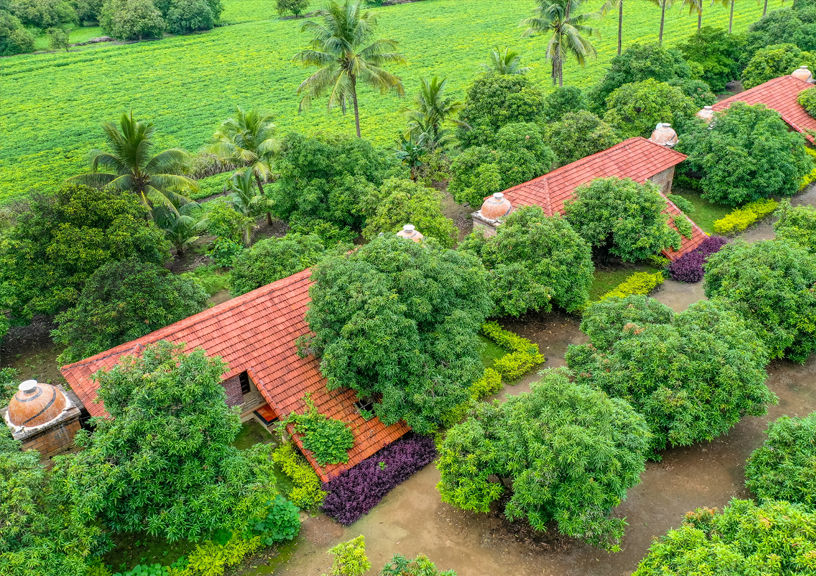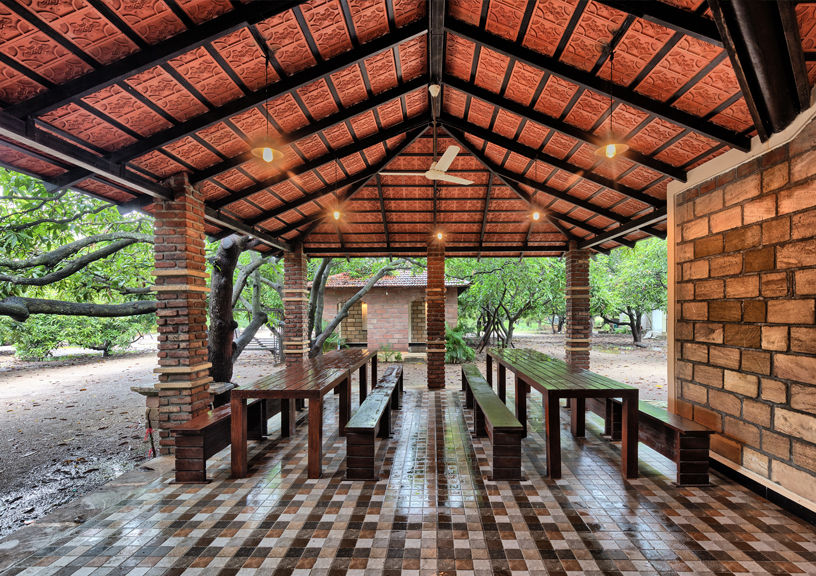



Set amidst picturesque rural settings at the edge of the famous Sasan Gir National Park in Gujarat, known for being the only home of the Asiatic lion, the agricultural farmstay of Aaranya was designed keeping in mind the overt principle of vernacular architecture. The design philosophy behind it believes that Mother Earth has enough for everyone’s needs, but not for everyone’s greed. This simple statement provides one of the greatest insights into the ecology of our planet. The concern for climate as well as economical and cultural sustainability has been factored into the design, as without these parameters sustainability may not work in the Indian context. Rather than spending millions on the best technology to create the greenest of green buildings that very few Indians can associate with and even fewer can afford, the architect here came up with simple, established and honest practices offered by vernacular architecture.
The roof is the most distinctive feature of the design and is made from terracotta, a material associated with the memory of many generations of Indian families. Terracotta has become a representative image of almost half a million Indian villages. The whole design thus evokes this one strong element of Indian architecture—the terracotta tiled roof. When glanced from the front, the sloping roof looks like it unites the earth and sky. Externally, the elongated tiled roof forms a distinctive presence yet one that is blended into the landscape. While internally, it shelters the entrance foyer and secures the visual privacy of the bedroom. In the near future, the entire roof will be covered in creeping plants emerging from the punctured roof and spread onto the tiled roof. Once the roof is fully covered by vegetation, the building will virtually disappear and truly become one with nature.
Native to this region, the twin cottage plan with a hip roof is intended to help offset the heat in summer and the heavy rainfall in monsoon. The longer surface of the cottages face the north-south direction, in order to minimise heat gain and maximise cross ventilation and air flow from the adjoining agricultural fields. With the objective to minimise its visual impact and its response to the earthquake prone area, the scale of the building has been kept grounded. The cottages were carefully designed so as to seem planted amongst the existing mango trees. The front yard with a mango tree is defined with natural bio fences constructed of shrubbery, and acts as a transition space between the more private cottage bedroom and the open farm area. An inbuilt sit-out in the foyer, along with twisted sandstone columns below the roof, adds drama to the welcoming space. This space also creates a refuge for contemplation and allows guests for an intimate interface with the outdoors. The building form allows one to instinctively experience the psychological assurance of security on one hand, and the exhilaration of exposure and proximity to nature on the other. One can almost feel a psychological transformation with the chirping of birds and the aroma of the flowers in this space. Once the guest is inside the cottage, they are cozy and protected and have everything that they might need, as if in a womb.
The bathroom has a dry and wet area separated with a small buffer space featuring a stained glass panel on one side and a waste glass bottle wall on the other. Vivid coloured daylight appears in the bathroom through that buffer, filling up the space with joy and excitement. The natural skylight from the dome above lights up the shower space and makes the bathing experience more refreshing.
The old construction techniques of using rubble stone-packed foundation, load-bearing exposed natural sandstone walls, brick dome with China mosaic on top and clay-tiled roof are not only cost-effective and time-tested, but also the architect’s way of helping create jobs for local villagers—as a step towards social sustainability and shared happiness. Every effort has been made to ensure that the cottages remain true to their context and testify themselves to the norms of vernacular architecture.
There is certainly an element of vulnerability in spending an evening on a local wooden charpai (bedstead) under the stars, listening to the wind rustling through the mango trees and the distant roar of a lion puncturing the quiet of the night. But more than that, such an experience brings a humbling awareness of one’s place in the world and creates a sweet harmony with earth. And this can happen only when we are able to connect to our roots and to Mother Nature.
Factfile
Project: Aaranya Farmstay, Gujarat
Architects: d6thD design studio, Ahmedabad
Client: Nishant, Dhanaji
Architect: Himanshu Patel
Construction team: Jagdish, Mansukh, Jitu, Ramnik, Nanji, Nitin
Year of completion: 2019
Text: Provided by the Architect
On the night of 1 April, Mumbai revealed her rebellious, punk-inspired side as Vivienne Westwood…
The architectural landscape of Rajasthan is steeped in a rich tradition of historic masonry, reflecting…
Are you a corporate employee spending 10+ hours in an ordinary cubicle that's fused in…
Modern Indian homes are no longer bound by their physical vicinity. They have outgrown our…
Häcker Kitchens, a brand synonymous with quality and innovation, has a rich legacy that spans…
In this home designed by Sonal R Mutha and Aniketh Bafna, founders and principal designers…